 |
"You know what
the trouble is going to be with this place? After a race like this, you’re
going to have to be here everytime Billy opens the doors."
- The late Gary Hajek, chassis builder, after attending the 1986 Chief
Nationals at the Texas Motorplex.
Billy Meyer’s Texas Motorplex opened its gates
on the weekend of August 2-3, 1986 after sustaining a rainout on its
originally scheduled maiden voyage of July 19-20. To say expectations
were high is to say now that the Denver Broncos will be hardpressed
to three-peat. The track contained all of the elements which drag race
buffs take for granted when world beating national-event sites are discussed.
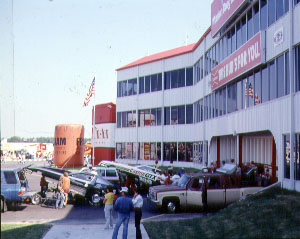 The
first of the what would be many three-story, half-hexagonal sponsor
suites buildings on the NHRA tour debuted immediately behind the starting
area, a launch site that introduced competitors to a then one-of-a-kind
all-concrete race course. Meyer’s facility also had the then largest
seating capacity with permanent aluminum bleachers constructed to hold
upwards of 29,000-plus fans. The facility sported a permanent racer’s
lounge, permanent restrooms and snackbars, and then state-of-the-art
electronic scoreboards. One could go on and on about the Motorplex,
but suffice to say it was drag racing’s first super facility, preceding
noble efforts at Baytown, Texas and Topeka, Kansas. The
first of the what would be many three-story, half-hexagonal sponsor
suites buildings on the NHRA tour debuted immediately behind the starting
area, a launch site that introduced competitors to a then one-of-a-kind
all-concrete race course. Meyer’s facility also had the then largest
seating capacity with permanent aluminum bleachers constructed to hold
upwards of 29,000-plus fans. The facility sported a permanent racer’s
lounge, permanent restrooms and snackbars, and then state-of-the-art
electronic scoreboards. One could go on and on about the Motorplex,
but suffice to say it was drag racing’s first super facility, preceding
noble efforts at Baytown, Texas and Topeka, Kansas.
Not only is the Motorplex the first big super site,
but it still holds up well to the aforementioned race venues. Over the
years, Meyer has upgraded the plant and kept it one of the highlights
of the tour, despite in recent years having to share a little of the
wealth with some copies of his plant. However, what really keeps it
high on anybody’s must-attend list is performance, in particular
nitro performance, and that happened right after the August 1986 match
race. If there is one race where the cliche, "Ya’ never know
what’s gonna happen" applies, it’s the Texas Motorplex.
Submitted for your approval would be the first race
at the plant in August 1986. The featured action was a best of three
match between local favorite and future Motorplex history maker, Eddie
Hill, and ex-NFL quarterback Dan Pastorini in the Coors Light dragster.
In addition, the new track owner put his 7-11/ Chief Auto Parts Mustang
against Mike Dunn in Joe Pisano’s Olds Firenza and hired in Pro
Stock ace Warren Johnson to take on Bruce Allen in the Levi Garrett/Reher-Morrison
Camaro.
The two nitro races wound up in a 1-1 tie, while Johnson
clipped Allen two straight before an estimated open nighter of 22,000
fans. What guaranteed future success both on and off the track were
the times posted on the revolutionary concrete surface.
Hill ran the fifth quickest elasped time ever with a
5.395, just four-thousandths below Gary Beck’s 5.391 record turned
in 1983. Beck ran two .39s, the record at the Winston Finals at Orange
County Int’l Raceway, Don Garlits ran a 5.37 at the Bakersfield
in May of 1986, and Darrell Gwynn logged a 5.34 at Englishtown, New
Jersey during the ‘86 Summernationals in July. A 5.395 was quite
an effort.
Both Meyer and Dunn logged 262.08 and 262.00 top speeds
respectively, which compared well to the 264.86 turned by Don Prudhomme
at the ‘85 Winston Finals. While Allen got trimmed by Johnson,
he hit the weekend’s high point with the best speed ever for a
Pro Stock, clocking a 187.34-mph charge.
Anyone with a faint knowledge of pro drag racing had
to be excited by the prospects of what would take place when the Motorplex
hosted its first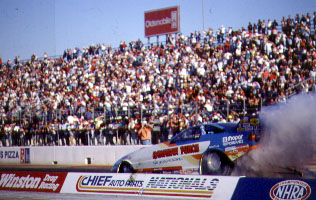 national event, the NHRA Chief Nationals on Sept.
25-28 of that year. Their anticipation was well rewarded because the
inaugural Chiefs produced the kind of action that moved the Motorplex
right to the top of "the quickest and fastest tracks" list. national event, the NHRA Chief Nationals on Sept.
25-28 of that year. Their anticipation was well rewarded because the
inaugural Chiefs produced the kind of action that moved the Motorplex
right to the top of "the quickest and fastest tracks" list.
Below is a listing of just some of the great occurences
that have given the Texas Motorplex the reputation it enjoys. No, I
am not trying for a totally comprehensive list, just one that crashes
the memory bell and sheds the proper light on what may be the country’s
most fabled dragstrip.
| 1986 |
- On the first nitro pass down track on Sept.
25, Darrell Gwynn runs the first Top Fuel 5.2-second run
and the first run over 275, with a stunning 5.280/278.29.
The record then was a 5.342 turned at Indy that year. Gwynn
would go on to set both ends of the NHRA record at 5.261/278.55.
- Kenny Bernstein’s Budweiser King would
shatter the 5.5-second Funny Car barrier when his 5.425
qualified No. 1 on Sept. 25. He could not back up so quick
a run, but a backed up 5.54 did break the then-current National
record of 5.569 set by Bernstein two weeks earlier at Maple
Grove Raceway in Pa.
- Mark Oswald pushed the Candies & Hughes/Old
Milwaukee Pontiac to a new NHRA mark of 268.09, eclipsing
Prudhomme’s 264.86.
- In each nitro field, over half of the racers
turned best ever elapsed times. An example, comng into Chiefs,
"Doc" Halladay had a best e.t. of 5.75 in his
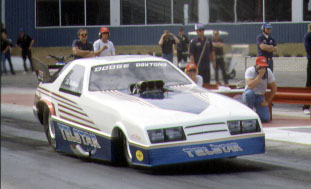
"Telstar" Dodge Daytona. On his first lap on Sept.
25, a 5.59/261.24 came up on the boards, good enough for
the No. 2 spot behind Bernstein’s killer run.
- The crowd was a stunner. Upwards of 81,000
fans took part in the Chiefs. How big is that? The Heartland
Park Topeka opener (and the track is first-rate in every
detail) drew about 68,000 in it’s opener in 1989.
- The masked, top hat-wearing "Bad Moon
Rising" wolves draw a howl from the home state crowd
when Chuck Phelps wheels his and Mickey Winters’ Pontiac
to the Alcohol Funny Car title.
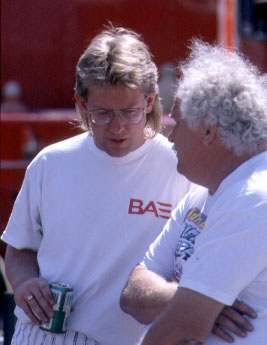
|
| 1987 |
- The Winston All-Stars race in April was every bit that.
Darrell Gwynn’s Budweiser Top Fueler ran the class’
first 5.1-second time with a 5.17 and Kenny Bernstein’s
Budweiser King Ford checked in with the first 5.3-second
run, a 5.39.
- The second Chief Nationals (Oct. 1-4) served as the backdrop
for the setting and resetting of 14 pro national records.
In Funny Car, John Force (5.453), Mark Oswald (5.449), Mike
Dunn (5.443), Force (5.396), and Ed McCulloch, who finally
landed the mark with a 5.366, put on one of the greatest
single battles for an NHRA Funny Car e.t. standard.
- In Top Fuel, Joe Amato logged the first 5.0-second run
on Oct. 2 with a 5.09/287.72 (the best speed ever) only
to have it bettered on the last run of the day by Gene Snow
with a 5.089 at just 267.06 mph. Neither driver backed up
their runs for records.
- The trek to the final record of 5.084 set by Gwynn’s
Budweiser dragster included Gwynn’s 5.123 and 5.092.
Eddie Hill got the speed national record with a 285.98-mph
blast.
- Dunn in Joe Pisano’s Olds became the first Funny
Car driver over 280-mph with a 280.72 charge in qualifying.
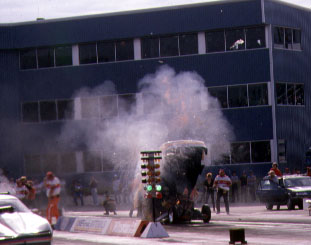
|
| 1988 |
- The IHRA Texas Nationals hosted on April 7-10 produced
20 IHRA pro settings and resettings of records, not the
least of which was Eddie Hill’s 4.990, turned on Apr.
9. This gave Hill the distinction of being the first Top
Fuel driver in the 4s.
- Ed McCulloch pushed the Miller High Life Olds Firenza
to a 5.255 to become the first Funny Car driver in the 5.2s
and net the IHRA mark.
- Bob Glidden became the new Pro Stock e.t. record holder
with a 7.318 effort.
- At the third IHRA Chief Nationals hosted Oct.29-Sept.
2, Scott Kalitta ran an unbacked- up 286.62-mph for the
best Funny Car speed of the decade. The best an NHRA sanctioned-race
would produce was a 283.28 by Oswald at the ‘89 Winston
Finals.
- Richard Holcombe became the third driver in the 4s with
a 4.988 charge in qualifying. Just ahead of him were four-fathers
Gene Snow (4.974) and Eddie Hill (4.993). Six fours, a record,
were produced in competition.
- McCulloch improved on his 5.255 of the Texas Nationals
with a 5.230 in qualifying.
- When Hill and McCulloch won the Chiefs, complementing
their Texas Nationals wins, they received a $100,000 bonus
from Meyer in addition to the purse, making them the highest
paid winners yet at a sanctioned drag event.
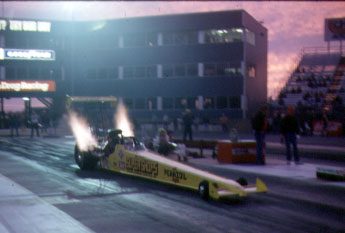
|
| 1989 |
- In terms of longevity, Ed McCulloch’s Miller High
Life Firenza ran one of the greatest (if not THE greatest)
Funny Car elapsed times ever with a non-backed-up 5.132
on Oct. 7 of the Chief Nationals. He ran a 5.188 that same
day for the NHRA mark. McCulloch’s 5.132 would not
be bettered until March of 1992. Jack Chrisman’s 7.60,
Don Prudhomme’s 5.63; none of those plums held on as
long as "the Ace’s" 5.13.
- A record 15 4-second runs were carded by Top Fuel dragsters
at the Chiefs and this at a time when the Cragar Four-Second
Club had only filled nine of 16 spots.
- Mike Brotherton was their ninth driver in the Cragar Club
with a 4.99, but it was his speed in the Williams Telecommunications
dragster that wowed everyone. He ran speeds of 292.49, 293.06,
and 294.88, all record speeds at the time they were turned.
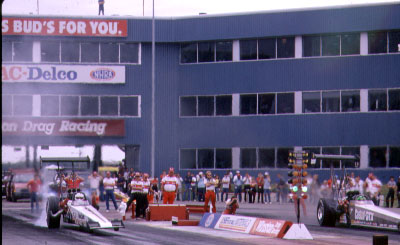
- Gary Ormsby’s four-day old Castrol dragster won the
race in the sport’s first side-by-side, four-second
final over Darrell Gwynn, 4.97 to 4.94, and ran off with
both ends of the NHRA mark at 4.91/(with a backed-up) 294.88.
He was also the first Top Fuel driver to run all fours in
a 16-car NHRA eliminator.
- Rookie driver Blaine Johnson duplicated Ormsby’s
feat in Alcohol Dragster. He ran 5.91, 5.92, and 5.97 in
qualifying and then all fives in eliminations, a first.
He also pushed the Johnson family dragster to the NHRA national
record with a 5.87.
|
| 1990 |
- For the first time since the Motorplex opened, new NHRA
nitro records were not set. Darrell Alderman did net both
the Pro Stock elasped time mark with a 7.18 and Warren Johnson
checked in with the speed mark at 192.18 mph.
- Bruce Larson ran Funny Car’s second-best elapsed
time with a 5.138 low e.t. charge at the Chiefs.
|
| 1991 |
- Jim White becomes the first Funny Car driver over 290-mph
with a 290.13 charge in Roland Leong’s Hawaiian Punch
Dodge. He backed it up with a 289.85-mph run on Oct. 11
of the Chiefs.
- Brooks Brown runs the sports first unblown five second
dragster pass, a 5.89 in his injected nitro dragster.
- Roland Forsberg run the first 6.80 comp dragster pass
in his A/ED "BackMouse" digger
|
| 1992 |
- Mark Oswald runs the best Funny Car class’ best speed
with a 293.06-mph blast in the Petosa Bros. Dodge Daytona
on Oct. 18 of the Chiefs. He didn’t back it up.
|
| 1993 |
- John Force runs the first NHRA sub-five-second Funny Car
national record with a 4.996 on Oct. 16 of the Chiefs.
- Ed McCulloch’s 301.70 in the McDonald’s/Joe
Gibbs dragster on Oct. 15 is the track’s first 300-mph
Top Fuel run.
- In a win rich with Texas tradition, Jackie Stidham and
brother Ronnie handled 100-degree conditions to win Alcohol
Funny Car. Wait a minute you say, the Stidhams are from
Oklahoma? Their dad, Jack Sr., played fiddle in Bob Wills’
Texas Playboys for a dozen years. Curb the tongue, knave.
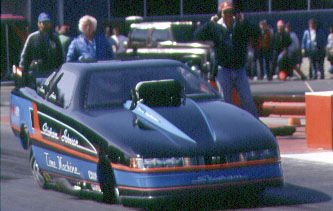
|
| 1994 |
- Record-wise, the most uneventful national event at the
Motorplex, although the fuelers were in the 4.7s and one
Funny Car (Force) in the fours (4.98).
|
| 1995 |
- Al Hofmann rockets to a 306.43-mph charge in the Western
Auto Firebird for the best Funny Car charge in history,
on Oct. 15 of the Chiefs.
|
| 1996 |
- Kenny Bernstein’s Budweiser King registers the best
Top Fuel speed ever with a 318.69 on Oct. 12, of the 11th
and last Chief Nationals.
|
| 1997 |
- Cory McClenathan pushes the McDonald’s dragster to
the sport’s first 320-mph run, a 321.77, turned on
Oct. 19 of the Revell Nationals. The run was backed up for
a new NHRA mark.
- On June 1-4, the Motorplex hosted a second NHRA national
event, the Lone Star Nationals. Joe Amato, John Force, and
Warren Johnson are the three pro winners.
- Joe Amato runs a 320.17-mph at the Revells for only the
second foray into that speed zone.
|
| 1998 |
- John Force becomes the first Funny Car driver to produce
a 4.7-second run when his 4.787 crops up on Oct. 24 of the
O’Reilly FallNationals.
- Gary Scelzi’s 4.525 in the Winston/Johnson Family
dragster turned the same day holds up as the new NHRA Top
Fuel e.t. mark.
- The Top Fuel field ranging from Scelzi’s 4.525 to
Randy Park’s 4.728 closes the year as the sport’s
quickest 16.
|
Photos by Jeff
Burk
|
 The
first of the what would be many three-story, half-hexagonal sponsor
suites buildings on the NHRA tour debuted immediately behind the starting
area, a launch site that introduced competitors to a then one-of-a-kind
all-concrete race course. Meyer’s facility also had the then largest
seating capacity with permanent aluminum bleachers constructed to hold
upwards of 29,000-plus fans. The facility sported a permanent racer’s
lounge, permanent restrooms and snackbars, and then state-of-the-art
electronic scoreboards. One could go on and on about the Motorplex,
but suffice to say it was drag racing’s first super facility, preceding
noble efforts at Baytown, Texas and Topeka, Kansas.
The
first of the what would be many three-story, half-hexagonal sponsor
suites buildings on the NHRA tour debuted immediately behind the starting
area, a launch site that introduced competitors to a then one-of-a-kind
all-concrete race course. Meyer’s facility also had the then largest
seating capacity with permanent aluminum bleachers constructed to hold
upwards of 29,000-plus fans. The facility sported a permanent racer’s
lounge, permanent restrooms and snackbars, and then state-of-the-art
electronic scoreboards. One could go on and on about the Motorplex,
but suffice to say it was drag racing’s first super facility, preceding
noble efforts at Baytown, Texas and Topeka, Kansas. national event, the NHRA Chief Nationals on Sept.
25-28 of that year. Their anticipation was well rewarded because the
inaugural Chiefs produced the kind of action that moved the Motorplex
right to the top of "the quickest and fastest tracks" list.
national event, the NHRA Chief Nationals on Sept.
25-28 of that year. Their anticipation was well rewarded because the
inaugural Chiefs produced the kind of action that moved the Motorplex
right to the top of "the quickest and fastest tracks" list.




